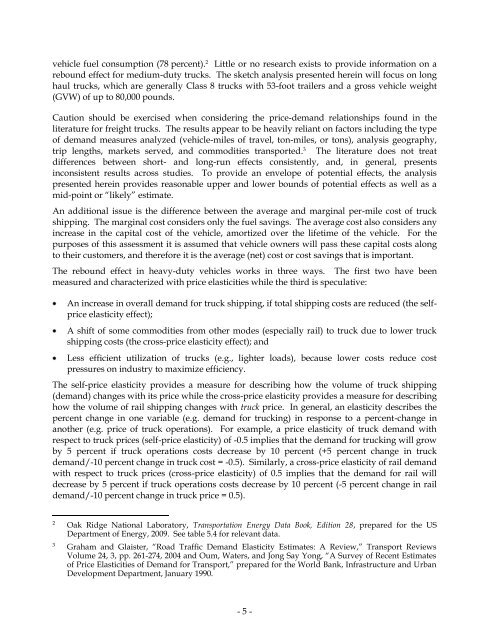Assessment of Fuel Economy Technologies for Medium and Heavy ...
Assessment of Fuel Economy Technologies for Medium and Heavy ...
Assessment of Fuel Economy Technologies for Medium and Heavy ...
Create successful ePaper yourself
Turn your PDF publications into a flip-book with our unique Google optimized e-Paper software.
vehicle fuel consumption (78 percent). 2 Little or no research exists to provide in<strong>for</strong>mation on a<br />
rebound effect <strong>for</strong> medium-duty trucks. The sketch analysis presented herein will focus on long<br />
haul trucks, which are generally Class 8 trucks with 53-foot trailers <strong>and</strong> a gross vehicle weight<br />
(GVW) <strong>of</strong> up to 80,000 pounds.<br />
Caution should be exercised when considering the price-dem<strong>and</strong> relationships found in the<br />
literature <strong>for</strong> freight trucks. The results appear to be heavily reliant on factors including the type<br />
<strong>of</strong> dem<strong>and</strong> measures analyzed (vehicle-miles <strong>of</strong> travel, ton-miles, or tons), analysis geography,<br />
trip lengths, markets served, <strong>and</strong> commodities transported. 3 The literature does not treat<br />
differences between short- <strong>and</strong> long-run effects consistently, <strong>and</strong>, in general, presents<br />
inconsistent results across studies. To provide an envelope <strong>of</strong> potential effects, the analysis<br />
presented herein provides reasonable upper <strong>and</strong> lower bounds <strong>of</strong> potential effects as well as a<br />
mid-point or ―likely‖ estimate.<br />
An additional issue is the difference between the average <strong>and</strong> marginal per-mile cost <strong>of</strong> truck<br />
shipping. The marginal cost considers only the fuel savings. The average cost also considers any<br />
increase in the capital cost <strong>of</strong> the vehicle, amortized over the lifetime <strong>of</strong> the vehicle. For the<br />
purposes <strong>of</strong> this assessment it is assumed that vehicle owners will pass these capital costs along<br />
to their customers, <strong>and</strong> there<strong>for</strong>e it is the average (net) cost or cost savings that is important.<br />
The rebound effect in heavy-duty vehicles works in three ways. The first two have been<br />
measured <strong>and</strong> characterized with price elasticities while the third is speculative:<br />
An increase in overall dem<strong>and</strong> <strong>for</strong> truck shipping, if total shipping costs are reduced (the selfprice<br />
elasticity effect);<br />
A shift <strong>of</strong> some commodities from other modes (especially rail) to truck due to lower truck<br />
shipping costs (the cross-price elasticity effect); <strong>and</strong><br />
Less efficient utilization <strong>of</strong> trucks (e.g., lighter loads), because lower costs reduce cost<br />
pressures on industry to maximize efficiency.<br />
The self-price elasticity provides a measure <strong>for</strong> describing how the volume <strong>of</strong> truck shipping<br />
(dem<strong>and</strong>) changes with its price while the cross-price elasticity provides a measure <strong>for</strong> describing<br />
how the volume <strong>of</strong> rail shipping changes with truck price. In general, an elasticity describes the<br />
percent change in one variable (e.g. dem<strong>and</strong> <strong>for</strong> trucking) in response to a percent-change in<br />
another (e.g. price <strong>of</strong> truck operations). For example, a price elasticity <strong>of</strong> truck dem<strong>and</strong> with<br />
respect to truck prices (self-price elasticity) <strong>of</strong> -0.5 implies that the dem<strong>and</strong> <strong>for</strong> trucking will grow<br />
by 5 percent if truck operations costs decrease by 10 percent (+5 percent change in truck<br />
dem<strong>and</strong>/-10 percent change in truck cost = -0.5). Similarly, a cross-price elasticity <strong>of</strong> rail dem<strong>and</strong><br />
with respect to truck prices (cross-price elasticity) <strong>of</strong> 0.5 implies that the dem<strong>and</strong> <strong>for</strong> rail will<br />
decrease by 5 percent if truck operations costs decrease by 10 percent (-5 percent change in rail<br />
dem<strong>and</strong>/-10 percent change in truck price = 0.5).<br />
2<br />
Oak Ridge National Laboratory, Transportation Energy Data Book, Edition 28, prepared <strong>for</strong> the US<br />
Department <strong>of</strong> Energy, 2009. See table 5.4 <strong>for</strong> relevant data.<br />
3<br />
Graham <strong>and</strong> Glaister, ―Road Traffic Dem<strong>and</strong> Elasticity Estimates: A Review,‖ Transport Reviews<br />
Volume 24, 3, pp. 261-274, 2004 <strong>and</strong> Oum, Waters, <strong>and</strong> Jong Say Yong, ―A Survey <strong>of</strong> Recent Estimates<br />
<strong>of</strong> Price Elasticities <strong>of</strong> Dem<strong>and</strong> <strong>for</strong> Transport,‖ prepared <strong>for</strong> the World Bank, Infrastructure <strong>and</strong> Urban<br />
Development Department, January 1990.<br />
- 5 -
















